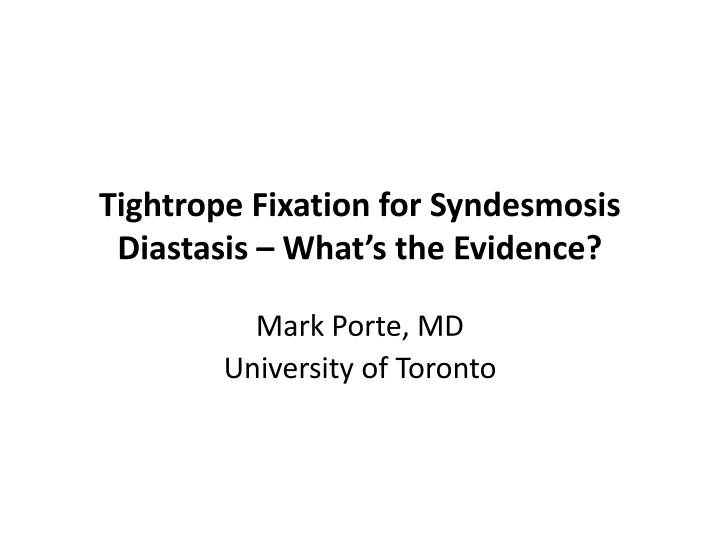
Tightrope Fixation for Syndesmosis Diastasis: What's the Evidence?
Explore the evidence and outcomes of using tightrope fixation for syndesmosis diastasis based on case series and biomechanical analyses. Learn about theoretical advantages, rehab protocols, and post-operative progress in treating traumatic ankle injuries.
Download Presentation

Please find below an Image/Link to download the presentation.
The content on the website is provided AS IS for your information and personal use only. It may not be sold, licensed, or shared on other websites without obtaining consent from the author. If you encounter any issues during the download, it is possible that the publisher has removed the file from their server.
You are allowed to download the files provided on this website for personal or commercial use, subject to the condition that they are used lawfully. All files are the property of their respective owners.
The content on the website is provided AS IS for your information and personal use only. It may not be sold, licensed, or shared on other websites without obtaining consent from the author.
E N D
Presentation Transcript
Tightrope Fixation for Syndesmosis Diastasis What s the Evidence? Mark Porte, MD University of Toronto
Case 39 YO active female External rotation injury to right lower extremity Fall with leg caught under her Unable to weight bear post injury On exam: Pain at syndesmosis. +ve squeeze test, +ve external rotation test
Follow-up 3 Months Rehab Protocol Splinted 0-2 weeks Aircast 2-6 weeks NWB ROM exercises Progressive WBAT at 6 weeks At last f/u good ROM (details not documented) Pain free weight bearing Progressing back to regular activities
Tightrope Theoretical Advantages Preserve physiologic motion? Reduce hardware pain? Eliminate need for second surgery? Earlier return to motion/activity?
Evidence? 4 Case Series Walking a tightrope: Our experience in the treatment of traumatic ankle syndesmosis rupture D. McMurray, B. Hornung, B. Venkateswaran, Z. Ati Treatment of syndesmotic disruptions with the Arthrex Tightrope: A report of 25 cases Cottom JM, Hyer CE, Philbin TM, Berlet GC Outcome and complications of treatment of ankle diastasis with tightrope fixation HJS Willmott, B. Singh, LA David Treatment of syndesmosis disruptions with TightRope fixation JC Coetzee, P Ebeling
Klitzman R, Zhao H, Zhang LQ, Strohmeyer G, Vora A. Suture-button versus screw fixation of the syndesmosis: a biomechanical analysis. Foot Ankle Int 2010 Jan;1(1):69-74 8 cadavers, 3 groups Intact ligaments Syndesmosis repaired with screw Syndesmosis repaired with tightrope Construct cycled under submaximal loads Syndesmotic gap less after loading (p=0.0004) in screw group compared to control and tightrope Increased coronal (p=0.0002) and sagital (p=0.005) plane motion after cycling in tightrope group compared to control Decreased coronal (p=0.00014) and sagital (p=0.0000012) plane motion after cycling in tightrope group compared to control Study conclusions: Tightrope construct more closely mimicked physiologic syndesmotic motion
D. McMurray, B. Hornung, B. Venkateswaran, Z. Ati. Walking a tightrope: Our experience in the treatment of traumatic ankle syndesmosis rupture. Injury Extra 2008;39:182. Prospective; sequential patients 16 patients All with associated fractures Mean follow-up 5.5 months Mean time to weight bearing 6 weeks No re-displacement 3 hardware removal (2 infection, 1 soft tissue irritation)
Cottom JM, Hyer CE, Philbin TM, Berlet GC. Treatment of syndesmotic disruptions with the Arthrex Tightrope: a report of 25 cases. Foot Ankle Int 2008 Aug;29(8)773-80. Retrospective review of 25 cases over 2y. Single Hospital Mean follow-up 10.8 months 21 using single tightrope, 4 using double tight rope Associated ankle fractures treated according to AO principles Mean time to weight bearing 5.5wks No evidence of re-displacement of syndesmosis No cases of hardware removal Considered a good option
Willmott HJS, Singh B, David LA. Outcome and complications of treatment of ankle diastasis with tightrope fixation. Int J Care Injured 2009;40:1204-5. Retrospective review, single hospital 6 cases met inclusion criterion 5 cases associated with ankle fracture Mean follow-up 6 months Mean time to weight bearing 6 weeks No evidence of re-displacement 2 cases of hardware removal secondary to soft tissue irritation
Coetzee JC, Ebeling P. Treatment of syndesmosis disruptions with TightRope fixation. Techniques in Foot and Ankle Surgery. 2008;7(3):196-202. Ongoing RCT Average follow-up 18.5 months 8 patients per group AOFAS (Ankle an hindfoot score) 94 vs 88 No evidence of syndesmotic loosening 1 tightrope removal for soft tissue irritation Trend toward increased ROM in tightrope group however screw not routinely removed
Conclusions Limited literature Appears to be a safe option No published evidence for re-displacement May necessitate tightrope removal (0-33%) Better range of motion compared to intact in situ screw in biomechanical testing
Conclusions Preserve physiologic motion? Compared with intact syndesmosis screw. Most likely Reduce hardware pain? Maybe? Eliminate need for second surgery? Maybe? Earlier return to motion/activity? Doesn t seem to be
Clinical Exam The Classics 2. Squeeze test 1. syndesmotic pain 4. Fibular translation 3. External rotation test
Tenderness Length In the absence of diastasis Length of tenderness measured from tip of lateral malleolus correlates with time to return to sport in sprains with no diastasis Nussbaum et al (2001)
Tenderness Length In the absence of diastasis Days Lost = 5 + [0.93xTL(cm)] +/- 3.7 Nussbaum et al (2001)
Manjoo A, Sanders DW, Tieszer C, MacLeod MD. Functional and radiographic results of patients with syndesmotic screw fixation: implications for screw removal. J Orthop Trauma. 2010 Jan;24(1):2-6. Retrospective review of 106 cases 76 underwent formal testing (mean f/u 23 mo) Outcomes: Lower Extremity Measure (LEM) and Olerud Molander score (OM) Decreased functional outcome in patients with intact syndesmosis screws. (LEM, p=0.01; OM, p=0.04) No functional difference between broken, loose or removed syndesmosis screws
